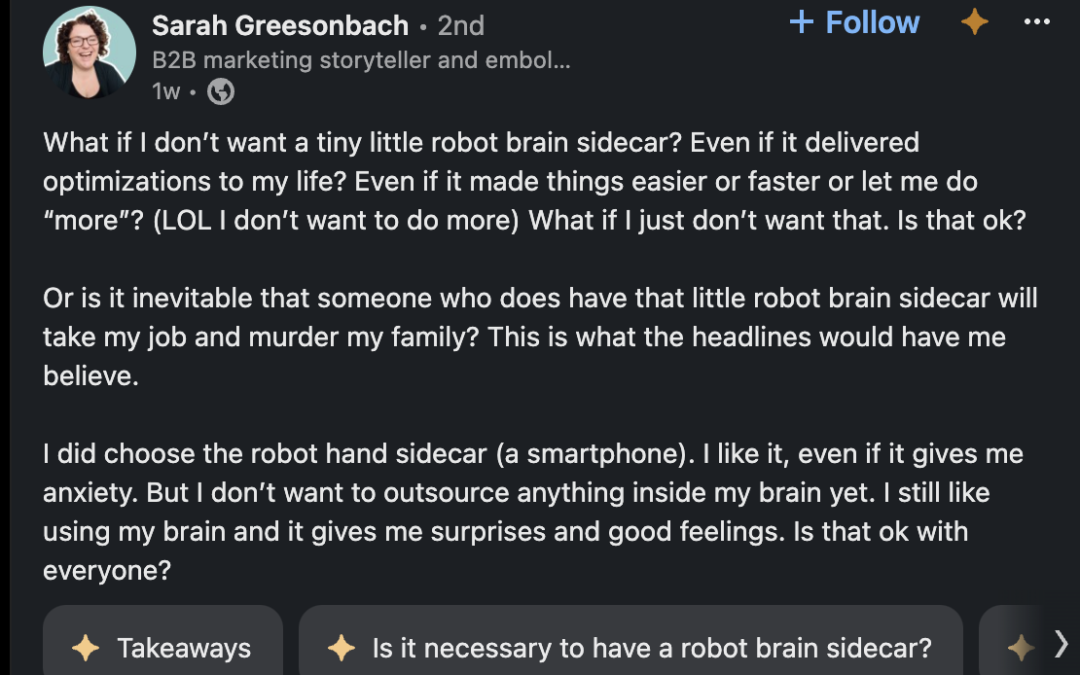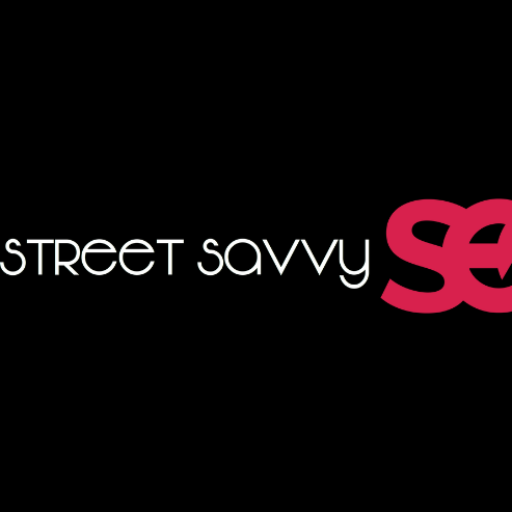Image credit: Writer screenshot of Sarah Greesonbach post about LinkedIn Takeaways (and it does a fabulous job of proving my point)
Forgive me for being unable to wrap my mind around how many people are in a sloppy lip-lock with artificial intelligence. Are they that naïve as to what’ll happen when AI’s sexy stare totally strips them naked…?
But that’s not exactly what this post is about.
It’s about AI’s growing presence in the tools, software, and platforms we’ve grown accustomed to using every day. And often, AI’s presence is unannounced, and we’re unaware. Worse than this is when there’s no off switch.
Now, don’t get me wrong—I am not against all artificial intelligence.
Certain forms of AI have well-intentioned applications in multiple industries. For example, the use of computer vision in healthcare has the potential to save uncountable lives by catching diseases, cancerous cells, etc. that the weary eyes of an overworked physician may not see. Computer vision and machine learning have applications in other fields, too, such as farming, agriculture, security, etc., and in these applications, these solutions actually fill a role as intended: as a helping hand that enhances, not replaces, a human’s role.
What I am against is generative AI.
And specifically, its use in creative industries. I’m against the “Hey, look! Free ice cream!” mentality that those who see no issue with generative AI use have adopted, calling those of us unwilling to accept and “embrace” the technology afraid of change. It’s this willful naivety that’s fueling generative AI’s fiery presence everywhere we look. And I say fiery because it’s burning a hole in the souls and pocketbooks of creators everywhere.
I say fiery because generative AI—if allowed to remain unchecked—could cause much more than just our inner children’s dreams to go up in flames. There are generative AI tools that can:
- Read
- Write
- Create images
- Create videos
And there are generative AI tools that can put anyone in videos.
Anyone, living or dead, with scary-real physical and vocal likenesses, like the George Carlin special not starring George Carlin (which immediately drew a federal lawsuit). Again, I don’t want to veer off the road and set the median’s weeds on fire, but all of those implications are real…and really dangerous.
What I do want is to bring to your attention—assuming you haven’t yet noticed—the trend of generative AI solutions popping up in places you wouldn’t necessarily suspect and without notice. Most importantly, without a way to opt out.
What are LinkedIn Takeaways?
If you don’t know what I’m talking about, it’s okay—it just means you haven’t yet received LinkedIn’s latest feature. The platform’s Takeaways buttons are the latest addition to its generative AI toolbox. Several generative AI buttons are now appended to the bottom of posts (your own and other users’) for all users who have the Takeaways feature. Users who don’t have the feature do not see these buttons even if they’re reading a post written by a user who does have the feature.
- Takeaways: This button summarizes the original user’s post.
- Buttons 2 through 3 (or 4): Various questions a reader might have after reading the post.
LinkedIn has been slowly (and by slowly, I mean slower than a turtle on a cold day) releasing this new feature since sometime in October 2023—I think. LinkedIn hasn’t publicized this feature’s release. As in, searching online didn’t yield any press releases. I did, however, find a LinkedIn post by Anna Burgess Yang (as well as an article she wrote about the topic on Medium) detailing her frustrations with the Takeaways buttons.
…and LinkedIn isn’t much help either—where’s the fanfare?
In LinkedIn’s Help section, I found this support document, this other support document, and a short set of FAQs, as well as similar documents about the buttons aimed at the job-posting side of the platform.). My curiosity was piqued, and I wanted to learn more—not just about the buttons themselves, but how users felt about this platform addition.
I surveyed several clients, colleagues, followers, and other connections. I also wrote a few posts on my own LinkedIn page to gauge user sentiment. I wanted to write this post for my blog the moment I first encountered the Takeaways buttons—then I thought, no, I need to view things I don’t agree with more subjectively. My opinions are not the only ones in the room, and I can accept that.
So, I decided to research.
I sent a survey to LinkedIn users asking if they do/don’t use Takeaways, if they do/don’t find the feature useful, and how they feel overall about LinkedIn jumping in on generative AI use. What I found in my research echoed my own thoughts on the tech, as well as many of the sentiments found in Anna Burgess Yang’s post’s comment section, which can be summed up perfectly in one word: Why?
Many users are confused or perplexed by LinkedIn Takeaways.
Mostly because they don’t yet have the feature—but even more so because many have never even heard of it.
I think LinkedIn’s cold-turtle rollout (and, of course, the lack of announcement) is to blame for this lack of knowledge. I just happened to notice the buttons in my Feed one afternoon, and I don’t know about you, but to me, that’s not good business. It reeks of deceptive, underhanded tactics by a platform we all use specifically for our businesses and careers.
My research takeaways on LinkedIn Takeaways
Here’s a breakdown of the numbers from my research:
- 20% of users have Takeaways
- Of the users who have Takeaways, 52% were unaware that they have it
- 80% of users don’t have Takeaways
- Of the users who don’t have Takeaways, 100% hadn’t heard of the feature
- 6% of users with Takeaways buttons like the feature
- 60% of users with Takeaways buttons don’t like the feature
- 34% of users with Takeaways had no opinion or didn’t understand the benefit
And that’s really the pressing issue here: LinkedIn is a place for professionals. Many of us use LinkedIn to interact with clients, colleagues, mentors, and industry leaders. Because these pages are sometimes a potential client’s introduction to us and our products or services, it’s rather important that we have a say in how we’re presented.
I asked respondents to leave comments regarding their takeaways on Takeaways, and here’s what some users had to say:
“I haven’t seen a quicker way to kill genuine human connection since Guantanamo.”
Mark Ankucic | Lever Edge Marketing, Sydney
“If I’m interested in [a] post, I will read it, not rely on AI to summarize it for me (good grief)!”
Anne Ryan | Ryan & Associates, California
“I don’t have any issue with this feature… I noticed these buttons when they first became available to me. But, honestly, I don’t even notice them anymore. And I don’t think it takes anything away from the platform’s purpose.”
Andi Robinson | Hijinx Marketing, Indianapolis
“Look, there’s nothing wrong with using AI to increase efficiency…But on a LinkedIn post? Read the room. The platform is a place to connect with people and engage in critical thinking. Relationships lose their meaning and significance when we hyper-optimize them.”
Hannah Szabo | We Are Visual, Brazil
“I think this feature comes from the misguided idea that adding AI to something will ALWAYS make it better…that kind of thinking is dangerous and can lead to ruining things that work by trying to ‘improve’ them with AI. Even the lengthiest LinkedIn posts are generally no longer than 300-400 words, which should take the average reader around 1-1.5 minutes to read. What time are you really saving? Although these Takeaways are presented as an efficiency feature, what they actually do is eliminate the entire point of what we are doing on LinkedIn in the first place… Why interrupt the very conversations the platform is meant for?”
Kelly Dunning | 100% Human Conversion Copywriter
“This new feature will cause more work for marketing teams. Now we need to think about what regular post readers will absorb from our content and what Takeaways-only readers need to absorb.”
Penny Gralewski | Marketing Executive, Chicago
“If they’re going to go ahead with this silliness, at least give us the ability to opt out of it.”
Scott Stransky | Full Funnel Content, Lisbon
So, what do you think? Are Takeaways a great addition? Or should LinkedIn take them away (or at least let us choose if we want to participate)? Let us know in the comments!
Do you need a trusted partner to create your webpage or blog post content? Maybe you need a second set of (human!) eyes for content edits. We offer these services, plus design, analysis, auditing, and general consulting. Check out our packages to find the perfect fit for your needs, or send J Lynn an email to design a package unique to your business.


